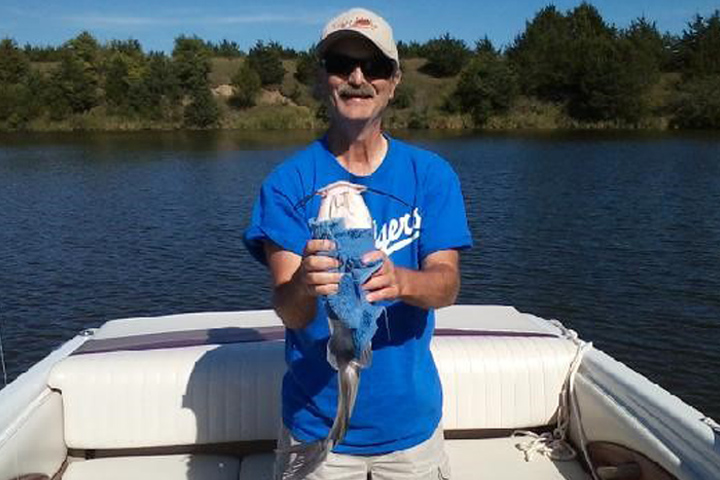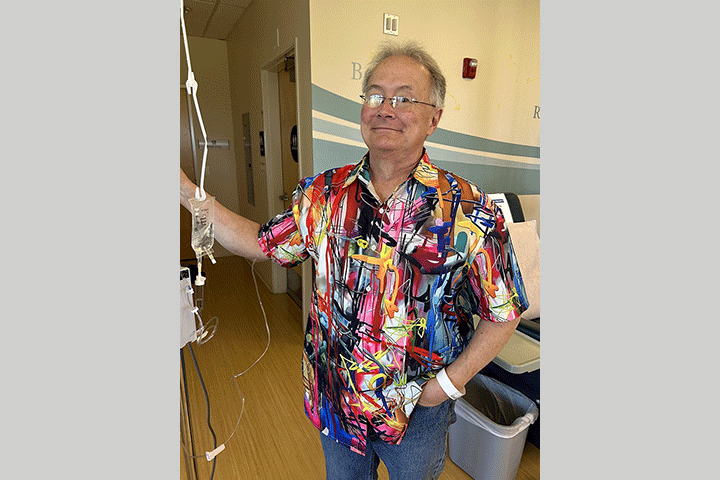Long-Term Survival After Grueling Radiation Treatment

- Bile duct blockage leads to discovery of tumor
- Whipple surgery removes the tumor
- Chemotherapy with Gemzar
- Radiation treatment plus chemotherapy with 5-FU
My name is Steven Yedwabnick, and I have resided in Sioux Falls, South Dakota, since 2005.
In the spring of 2006 I noticed I was getting a large amount of heartburn and indigestion. I had had it in the past so I treated it with a large amount of Zantac. But this time the drug didn’t help the symptoms at all, which was unusual. In August 2006 I found I had a little noticeable mental fatigue, as well as occasional forgetfulness.
Then, in September I failed a routine physical for life insurance; the reason given was high liver enzymes. I researched high liver enzymes on the internet, and found that large amounts of Zantac can sometimes lead to higher levels of liver enzymes, so I didn’t get alarmed yet. I went to Dr. Angela Meyer, my primary care doctor, in November and showed her the results with the high liver enzymes. We both agreed that I should continue my diet and that would probably cause a drop in the liver enzymes. She thought I might have a fatty liver but I didn’t drink so it didn’t make sense.
A week later I realized I had lost 10 pounds, my stool had turned white, and I was completely jaundiced. The itching was awful—I couldn’t sleep—and then I couldn’t urinate. After a CT scan I was admitted to the hospital. I had to wait a weekend until the doctor could go down the esophagus with a scope and put a stent in my bile duct, which had been closed for 48 hours.
A Serious Diagnosis
Dr. Dany Shamoun (now practicing in Orlando, Florida) insisted on an additional procedure, in which he took 10 biopsy samples and looked at the area around the pancreas and bile duct for the cause of the trouble. He advised us that there was something in the pancreas and that he thought it was a tumor. Dr. Meyer and the Avera Gastroenterology Group made an appointment for us to be seen at the Mayo Clinic in Rochester, Minnesota, in December.
At the Mayo Clinic I had an exam that included a CA 19-9. But the CA 19-9 level was too low to indicate pancreatic cancer, so the doctor thought I most probably had autoimmune pancreatitis. The expert in this field was out until the following Tuesday so we made an appointment for Tuesday, December 5th. That morning I had a needle biopsy, which showed that the tumor in the pancreas was cancerous. My appointment was switched to Dr. Michael Farnell, who at that time was the head of the pancreatic cancer unit at the Mayo Clinic, head of gastro surgery, and a board member.
Dr. Farnell explained to us that the tumor was located at the head of the pancreas. If I did not have an operation I would live about five months. Based on my tests and the location of the tumor, he could just about guarantee that he would be able to perform a very complicated surgery called a Whipple surgery. With the surgery I had about a 20 percent chance to live five years.
Surgery was scheduled for December 11th. My birthday is December 10th—I spent that day prepping for the Whipple. The surgery was successful, and a 2 cm tumor was removed. Dr. Farnell diagnosed me as stage IIb, because he believed that during the needle biopsy some of the cancerous material had spilled out. He said that the tissue looked great and he thought that they probably got all of the tumor. The operation removed my duodenum, gall bladder, at least half of my pancreas, and rerouted my bile duct. I had the best surgeon available. Subsequently I have had very few complications compared to many people I know who have had similar surgery.
Chemotherapy and Radiation
While I was in the hospital I was asked if I would donate all of the tissue that was removed to an ongoing study at the University of Minnesota and led by Dr. Gloria Petersen of the Mayo Clinic. I had to complete surveys, questionnaires, and follow-up paperwork.
My doctors at Mayo recommended a treatment protocol that involved chemotherapy and radiation. After a two-week break, I started treatment. I had two three-week chemo treatments with Gemzar with one week off between the treatments. This was done in Sioux Falls, coordinated by my oncologist Dr. Mark Huber, who had done his residency at Mayo. Next was a seven-week protocol involving 35 radiation treatments and significant chemo. I would have to live at the Mayo Clinic for these treatments. So I headed to Rochester to start the seven weeks in “hell.”
The Gemzar treatments produced no side effects for me whatsoever, so I didn’t know what to expect. I also received 5-FU 24/7 for 42 days straight. After 7-10 days I stopped eating—I had mouth sores, fatigue, and loss of fluids. Twice during this time I needed intravenous fluids, but I managed okay despite losing 21 pounds in 42 days. I was now down about 35-40 pounds from the onset of symptoms back in November. But I managed to walk the two blocks from where I was staying to the hospital for all of my 35 radiation treatments.
After about a three-week break from the radiation and 5-FU, I went back home and started the Gemzar treatment cycle again. I did two complete rounds of this, for a total of eight weeks.
The Importance of Advocacy
My treatments ended July 5, 2007. In August I had to start Creon pancreatic enzymes because of the damage that was done to the pancreas during radiation. I went more than five years without needing help with blood sugar, but I had to go on Metformin to lower my blood sugar. It has worked fantastically with no symptoms and my A1C, a marker for blood sugar levels, is down to 6.2. I feel terrific.
I stopped getting scans after five years and on December 11, 2018, I became a 12-year pancreatic cancer survivor. I never had any reoccurrence. I have a great quality of life and can pretty much digest food with help from the enzymes. However, I cannot gain a pound.
I have volunteered for Pancreatic Cancer Action Network (PanCAN) for about seven years, the last four as State of South Dakota Advocacy Chair. During this time, I have spoken to 800+ people at Purple Stride, the Mayor’s office and City Council, have been in to the offices of Senators John Thune and Mike Rounds, and then-Representative Kristi Noem, advocating for funds for pancreatic cancer research.





